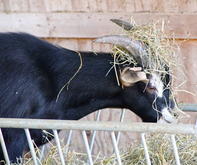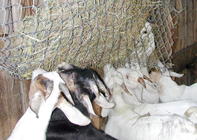
Extensive Feeding Programmes for Goats
Goats are grazers and browsers and are therefore are able to utilize grasses and shrubs. In an extensive system, the quantity and quality of the natural forages determine the milk yield of a goat. The milk yield of goats on natural forage is usually low and erratic often resulting in short lactation periods. In communal areas, goats are usually outside during the day browsing on natural shrubs, grasses and crop residues. At night they might be put in a kraal where they can receive supplementary feed such hays, straws and some concentrates.Goats in Intensive Feeding Systems

For intensive conditions, dairy goats can be kept on cultivated pastures or in a housing system or open camps. Cultivated pastures require irrigation as the natural rainfall in South-Africa is not sufficient to ensure a year-round pasture-based system.
When using open camps, goats should be protected against heat and rain. Feed troughs should provide enough feeding space (0.3 - 0.5 m per goat) to ensure that all goats have free access to feed. To reduce feeding costs farm-produced forages should be used in diets.
Concentrates to Increase Milk Yield
Concentrates are used to supplement the feeding quality of forages and to increase the milk yield of goats. The energy and protein content of the concentrate depends on forage quality and the milk yield levels, lactation stage and the age of goats.
Energy and protein requirements are usually higher in early lactation when milk yield is high and lower at the end of the lactation period. Concentrates supplied by a feed company are generally expensive. The amount to be fed depends on the milk yield of goats.
Feeding high levels of concentrates may be uneconomical and may also result in rumen upsets as goats are ruminants and therefore require minimum amounts of forages in the diet. It is possible to source concentrated feeds (maize, protein sources, minerals) to formulate and mix your own farm rations.
It is, however, important that a qualified and knowledgeable nutritionist formulates the mixtures. For small dairy goat farmers, it is often easier to purchase a standard dairy meal from a feeding company instead of mixing one yourself.
The Milk Cycle in Goats
Milk production starts after lambing, and depending on the genetic merit and feeding level of the goat, the lactation period may last from 240 to 300 days. Extensively farmed indigenous goats may have shorter lactation cycles (150 - 180 days) usually because of poor generic merit and inferior feeding.
Good quality forages like lucerne hay (rich in proteins) should be fed to lactating goats supplying at least 40 - 60% of the daily feed intake. The amount of concentrates is determined by the milk yield of goats. A high-yielding dairy goat producing 4 - 5 litres of milk per day requires at least 3 - 4 kg feed.
Of this 40 - 60% can be a concentrate mixture i.e. 1.2 to 1.6 kg to 1.6 to 2.4 kg per goat per day. Dairy goats producing less milk can be fed a smaller amount of concentrates.
Feeding of Dry Dairy Goats
Dry or non-lactating dairy goat require only good quality roughage. This can be lucerne or oat hay. When goats are too thin in the last month of pregnancy a small amount, i.e. about 0.5 kg/day of concentrates can be included in the diet. It is, however, better for goats to regain condition during the second half of lactation, rather than trying to achieve this during the dry period.
If there is not enough energy in the diet in the late pregnancy and around lambing, fat reserves will be mobilized. When the demand is high because of multiple fetuses, the liver may not be able to cope, and the goat may develop a condition known as ketosis (“pregnancy toxaemia”) which requires immediate treatment.
Please note: Information is for educational and informational purposes only and may not be construed as feeding or nutritional advice. For more information on feeding your animals contact your animal health technician, veterinarian or animal feed supplier.
By Dr Carel Muller